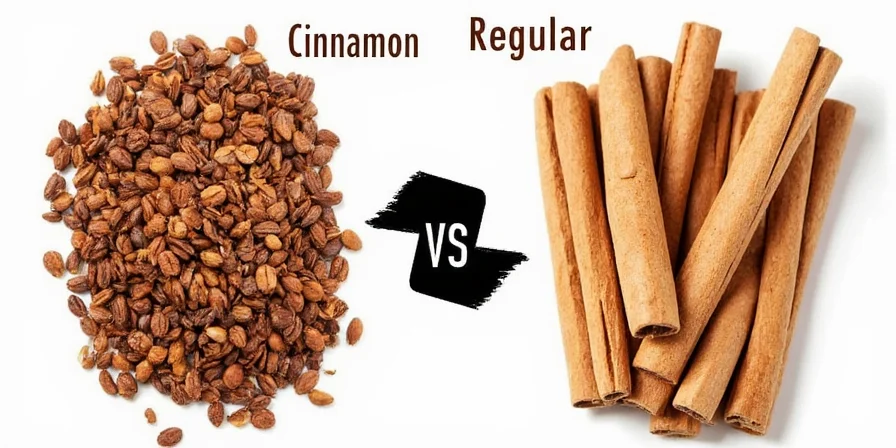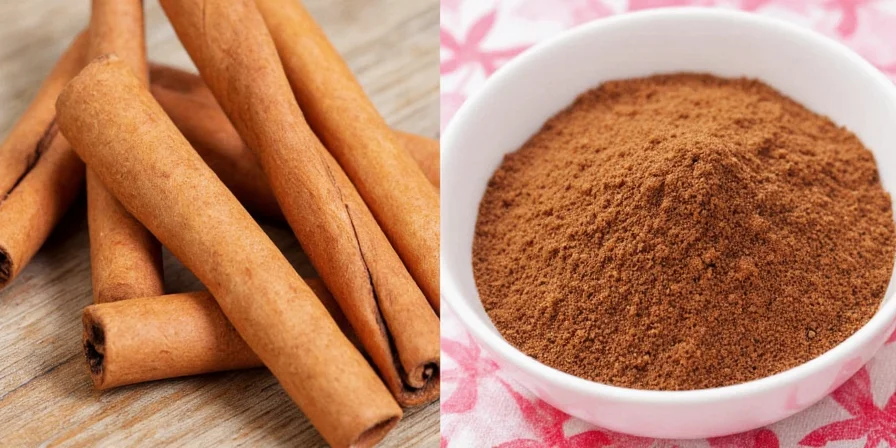Ceylon cinnamon is safer for daily consumption due to negligible coumarin levels (<0.04%), while Cassia (regular) cinnamon contains high coumarin (up to 1%)-exceeding EFSA safety limits with regular use. Choose Ceylon for daily health benefits or Cassia for occasional bold recipes. This evidence-based comparison reveals critical differences in safety, flavor, and sustainability that directly impact your health and cooking results.
Contents
- What Is Ceylon Cinnamon?
- What Is Cassia (Regular) Cinnamon?
- Critical Differences: Health, Safety, and Practical Use
- Coumarin Content: The Hidden Health Risk You Must Know
- Regulatory Timeline: Safety Standard Evolution
- When to Use Each Type: Expert Application Guide
- How to Identify Authentic Ceylon Cinnamon
- Optimal Storage Methods for Maximum Freshness
- Sustainability Impact: Ethical Sourcing Considerations
- Critical Safety Questions Answered
- Final Recommendation Based on Usage Frequency
What Is Ceylon Cinnamon?

Ceylon cinnamon (Cinnamomum verum), often called "true cinnamon," originates from Sri Lanka and southern India. This premium variety features thin, multi-layered bark sticks with a light tan color. Its distinctive structure comes from carefully harvesting only the inner bark of young trees, preserving the plant for sustainable regrowth.
Flavor profile: Delicate, sweet, and complex with citrusy notes - ideal when you want cinnamon to enhance rather than dominate. European Food Safety Authority recognizes its safety for daily consumption due to minimal coumarin content.
What Is Cassia (Regular) Cinnamon?
Cassia cinnamon (Cinnamomum cassia), commonly labeled as "regular" cinnamon, primarily comes from Indonesia, China, and Vietnam. This variety constitutes 90% of cinnamon sold in supermarkets. Unlike Ceylon, Cassia uses the entire bark layer, resulting in thick, hard, single-layer sticks with a dark reddish-brown color.
Flavor profile: Intensely spicy with a slightly bitter aftertaste - perfect when bold cinnamon flavor is desired. However, its high coumarin content (5-12mg per teaspoon) requires consumption limits to avoid potential liver toxicity with regular use.
Critical Differences: Health, Safety, and Practical Use
Key distinctions that impact your health and cooking results:
| Critical Factor | Ceylon Cinnamon | Cassia Cinnamon | Verification Source |
|---|---|---|---|
| Health Safety (Coumarin) | 0.004-0.035% - Safe for daily use (EFSA compliant) | 0.4-1.0% - Exceeds EFSA limits with regular consumption | J. Agric. Food Chem. 2018 |
| Daily Safe Limit | Unlimited | Maximum 0.5 tsp (2.5g) for 130lb/60kg adult | EFSA 2018 Re-evaluation |
| Visual Identification | Multiple thin layers, light tan, brittle texture | Single thick layer, dark brown, hard texture | HK Centre for Food Safety |
| Flavor Intensity | Mild (use 1.5x more to match Cassia) | Strong (dominates other flavors) | Food Chemistry 2017 |
| Price Comparison | $$-$$$ (5-10x more expensive) | $ (widely affordable) | FAO Cinnamon Market Report |
| Best Culinary Uses | Daily beverages, delicate desserts, savory dishes | Occasional bold recipes, holiday baking, spice rubs | IFT Ingredients Database |
Coumarin Content: The Hidden Health Risk You Must Know
This is the most critical difference affecting your health:
- Ceylon cinnamon contains only 0.004-0.035% coumarin - well below European Food Safety Authority's threshold. You can safely use it daily without health concerns. Multiple peer-reviewed studies (Journal of Agricultural and Food Chemistry) confirm its safety profile.
- Cassia cinnamon contains 0.4-1.0% coumarin - meaning just one teaspoon delivers 5-12mg of this compound. EFSA recommends maximum 0.1mg coumarin per kg of body weight daily. For a 60kg adult, that's just 6mg - less than one teaspoon of Cassia.
Long-term excessive coumarin intake may cause liver damage, especially in sensitive individuals. The FDA acknowledges this risk but hasn't established limits, while EFSA's guidelines provide clear safety parameters.
Regulatory Timeline: Safety Standard Evolution
Key milestones in coumarin regulation based on scientific evidence:
- 2008: European Food Safety Authority (EFSA) establishes first coumarin limits at 0.1mg/kg body weight after liver toxicity concerns (EFSA 2008 Opinion)
- 2011: German Federal Institute of Risk Assessment (BfR) confirms Cassia as primary coumarin source in foods, recommending consumer awareness (BfR 2011 Report)
- 2018: EFSA reconfirms safety limits after comprehensive review of 120+ studies, citing Ceylon as safe alternative (EFSA 2018 Re-evaluation)
- 2022: FDA issues consumer guidance differentiating cinnamon types due to rising liver injury reports (FDA 2022 Update)
When to Use Each Type: Expert Application Guide
Maximize flavor and safety with these professional recommendations:
Usage Boundaries by Body Weight (Cassia Only)
EFSA's 0.1mg/kg limit creates critical usage thresholds. Calculations based on EFSA 2018 methodology using Cassia's maximum coumarin content (12.5mg/tsp):
| Body Weight | Max Cassia (tsp/day) | Critical Limit Condition |
|---|---|---|
| 50 kg (110 lbs) | 0.4 | Exceeds limit with just 1/2 tsp |
| 70 kg (154 lbs) | 0.6 | Exceeds limit with 2/3 tsp |
| 90 kg (198 lbs) | 0.8 | Exceeds limit with 4/5 tsp |
Note: These limits apply to healthy adults. Individuals with liver conditions must avoid Cassia entirely (per American Liver Foundation).
Use Ceylon Cinnamon When:
- Preparing daily beverages (coffee, tea, golden milk)
- Baking delicate French pastries or Scandinavian desserts
- Creating subtle spice blends for chicken or fish dishes
- Adding to yogurt, oatmeal, or smoothies for daily consumption
- Seeking blood sugar regulation benefits without health risks
Use Cassia Cinnamon Sparingly When:
- Making bold holiday recipes (once or twice yearly)
- Creating intensely spiced rubs for meats
- Baking traditional cinnamon rolls where strong flavor is essential
- Preparing winter beverages like mulled wine for special occasions
- Working within tight budget constraints for infrequent use
How to Identify Authentic Ceylon Cinnamon
Follow these verification methods to avoid mislabeled products:
- Label Check: Look for "Cinnamomum verum" or "True Cinnamon" - "Ceylon" alone isn't sufficient as some Cassia is mislabeled
- Physical Examination: Authentic Ceylon has multiple paper-thin layers that crumble easily when bent
- Color Test: Pure Ceylon appears light tan to pale brown, never dark reddish-brown
- Solubility Check: Ceylon dissolves more completely in liquids than Cassia
- Certification Verification: Look for Sri Lankan government certification (Ceylon Cinnamon logo)
Optimal Storage Methods for Maximum Freshness

Preserve potency and safety with these storage protocols:
- Store both types in airtight amber glass containers to block light degradation
- Maintain temperature below 70°F (21°C) - never store near stoves or ovens
- Ground cinnamon retains peak quality for 18 months; sticks for 3 years
- Perform freshness test: Fresh cinnamon should leave tingling sensation on tongue
- Never store in plastic containers - essential oils can degrade plastic over time
Sustainability Impact: Ethical Sourcing Considerations
Your choice affects global ecosystems and communities:
- Ceylon production: Traditional Sri Lankan methods use sustainable bark harvesting from young trees (Cinnamomum verum), allowing regrowth without killing the tree. This supports biodiversity and provides year-round income for smallholder farmers.
- Cassia concerns: Some Indonesian Cassia production involves clearing natural forests for monoculture plantations. Look for organic or Fair Trade certifications to ensure ethical sourcing.
- Carbon footprint: Ceylon typically has lower transportation emissions when purchased in Europe/US due to established shipping routes from Sri Lanka
- Ethical tip: Choose brands with transparent supply chains - the best provide farm-to-jar traceability
Critical Safety Questions Answered
How much coumarin is actually dangerous?
The European Food Safety Authority sets the tolerable daily intake at 0.1mg per kg of body weight. For a 150lb (68kg) adult, that's 6.8mg maximum. One teaspoon of Cassia contains 5-12mg of coumarin - meaning even moderate daily use exceeds safety limits. Ceylon contains negligible amounts (0.017mg per teaspoon), making it safe for unlimited consumption.
Can I use Cassia cinnamon if I have liver disease?
No. Individuals with pre-existing liver conditions should completely avoid Cassia cinnamon due to coumarin's hepatotoxic effects. The American Liver Foundation recommends Ceylon exclusively for those with liver concerns. Even small amounts of Cassia could exacerbate liver damage in susceptible individuals.
Does grinding affect coumarin levels?
No - coumarin content remains consistent whether cinnamon is whole or ground. However, grinding fresh sticks maximizes flavor compounds while preserving safety profile. Pre-ground cinnamon often contains fillers and may have been sitting on shelves longer, reducing overall quality without changing coumarin levels.
Are there reliable tests to identify cinnamon types?
Yes. The most accurate method is HPLC (High-Performance Liquid Chromatography) testing for coumarin levels. For home identification: 1) Bend test - Ceylon bends and crumbles, Cassia snaps; 2) Layer check - Ceylon has multiple thin layers; 3) Taste test - Ceylon is sweeter with less heat. Reputable brands provide third-party testing documentation for authenticity verification.
Final Recommendation Based on Usage Frequency
Make the right choice for your specific needs:
- Daily users (health-focused): Ceylon is the only safe option. Its negligible coumarin levels eliminate health risks while providing consistent blood sugar benefits. The higher price pays for itself in long-term wellness.
- Occasional users (bold flavor needs): Cassia works for special occasion recipes where intense flavor is required, but strictly limit to maximum 0.5 teaspoon per serving and no more than 1-2 times weekly.
- Professional solution: Maintain both types in your kitchen - Ceylon for daily use and Cassia for specific bold recipes. This approach optimizes both safety and flavor impact without compromise.
The evidence is clear: When choosing between Ceylon vs Cassia cinnamon, health considerations should drive your decision more than flavor preference. For regular consumption, Ceylon's safety profile makes it the only responsible choice. Reserve Cassia for rare occasions where its bold character is essential to the recipe's success.











 浙公网安备
33010002000092号
浙公网安备
33010002000092号 浙B2-20120091-4
浙B2-20120091-4